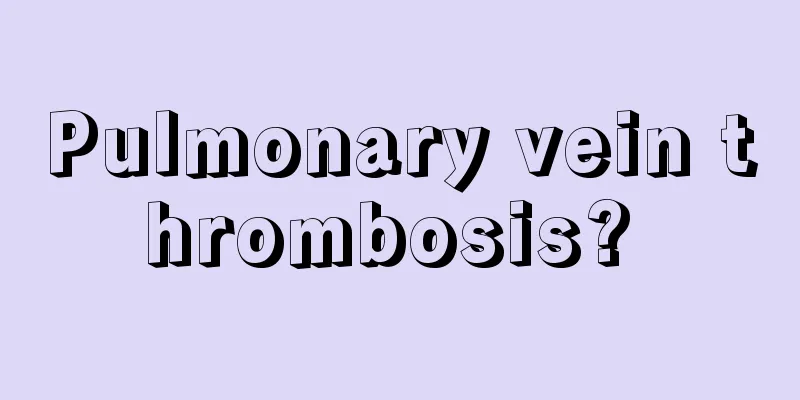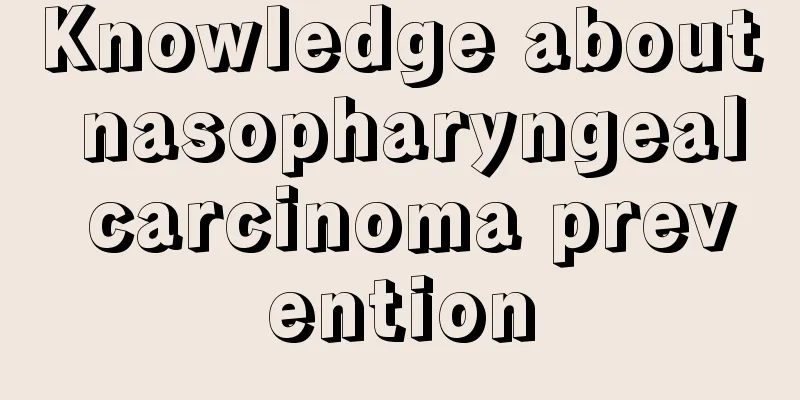Pulmonary vein thrombosis?

|
Pulmonary embolism is a pathological phenomenon caused by an impaction that enters the pulmonary artery and blocks the blood supply to the tissues. Pulmonary embolism can cause great harm to the human body and may cause pulmonary infarction or cardiogenic shock. Pulmonary vein embolism is a disease that threatens human life, so we must pay attention to it. Usually, treatment is mainly with blood-activating drugs, and we also need to develop good living habits. Pulmonary embolism (PE) is a general term for a group of diseases or clinical syndromes caused by various emboli blocking the pulmonary artery system, including pulmonary thromboembolism (PTE), fat embolism syndrome, amniotic fluid embolism, air embolism, etc. Treatment 1. First aid measures l. General treatment: Intensive care is recommended, bed rest is required for 1-2 weeks, and analgesics and sedatives are given to patients with severe chest pain. 2. Correction of acute right heart failure (dopamine, etc.) 3. Prevent and treat shock. 4. Improve oxygenation and ventilation function by oxygen inhalation or non-invasive mask ventilation, and endotracheal intubation and artificial ventilation when necessary. 2. Thrombolytic Therapy 1. Indications for thrombolysis: The time window for thrombolysis is generally stipulated to be within 14 days. However, in view of the possible dynamic formation process of thrombus, this time window is not absolute. The currently recognized indication for thrombolytic therapy is massive pulmonary thromboembolism, which is characterized by right heart failure with hypotension or cardiogenic shock. For such patients, if there are no contraindications to treatment, thrombolytic therapy should be given actively and quickly. 2. Absolute contraindications: active internal bleeding, recent spontaneous intracranial hemorrhage. 3. Relative contraindications: major surgery within 2 weeks, delivery, organ biopsy, or vascular puncture that cannot compress the bleeding site; ischemic stroke within 2 months; gastrointestinal bleeding within 10 days; severe trauma within 15 days; neurosurgery or ophthalmology surgery within 1 month; difficult to control severe hypertension (systolic blood pressure>180mmHg, diastolic blood pressure>110mmHg); recent cardiopulmonary resuscitation; platelet count <100×109/L; pregnancy; bacterial endocarditis; severe liver and kidney dysfunction; diabetic hemorrhagic retinopathy, etc. Clinical classification 1. Acute pulmonary thromboembolism 1. The main clinical manifestations of massive PTE are shock and hypotension, that is, the systemic arterial systolic pressure is <90 mmHg, or the decrease from the baseline value is ≥40 mmHg, which lasts for more than 15 minutes. Other causes of blood pressure drop, such as new arrhythmia, hypovolemia, or infection and toxins, must be excluded. 2. Non-massive PTE does not meet the above criteria for massive PTE and does not cause shock or hypotension. Some cases of non-massive PTE present with clinical right heart failure or right ventricular weakening (right ventricular anterior wall motion amplitude <5 mm) on echocardiogram, which is a subtype of sub-massive PTE. 2. Chronic thromboembolic pulmonary hypertension (CTEPH) It can often be traced back to the clinical manifestations of chronic, progressive pulmonary hypertension, with right heart failure occurring in the later stage; imaging examinations confirm pulmonary artery obstruction, which is often multi-site and extensive, with signs of chronic embolism such as masses adhering to the vascular wall, surrounding or eccentrically distributed, and with a tendency to calcification in the pulmonary artery; DVT can often be found; right cardiac catheter examination shows that the mean pulmonary artery pressure at rest is >25 mmHg, and the mean pulmonary artery pressure after activity is >30 mmHg; echocardiography shows right ventricular wall thickening (right ventricular free wall thickness >5 mm), which meets the diagnostic criteria for chronic cor pulmonale. |
<<: What causes high fucosidase levels?
>>: Why do you need to drill a hole in your teeth?
Recommend
Treatment methods and precautions for chronic antral gastritis
The occurrence of chronic antral gastritis is one...
What are the symptoms of fibrous bone hyperplasia?
In life, many people have encountered the problem...
Runny nose and ringing ears
Everyone must have had the feeling that when you ...
What to pay attention to before blood sugar test
Blood sugar testing is very necessary, whether it...
The skin around the nails becomes hard and cracks
The hardening and cracking of the skin around the...
How long can a person with gastric cancer brain metastasis live? It depends on the severity of the disease
The survival period of gastric cancer brain metas...
What is the reason for sticky sweat
Sweating in the summer is a very normal phenomeno...
The difference between impacted teeth and wisdom teeth
Oral health is very important because it is close...
What to do if your hair smells bad
Having clean hair will make a person feel refresh...
How to distinguish glioma
As the pressure of human life increases, the amou...
Can washing hair with mulberry leaves cure gray hair?
Nowadays, people are under increasing pressure, a...
Can I eat fruit if I have diarrhea?
When you have diarrhea, you must pay attention to...
What to do if you are pregnant with gallbladder cancer
What should patients do if they are pregnant with...
How to sober up quickly after getting drunk
Although it is usually recommended that people do...
What foods can help maintain hair?
Whether your hair is smooth and flowing depends o...









